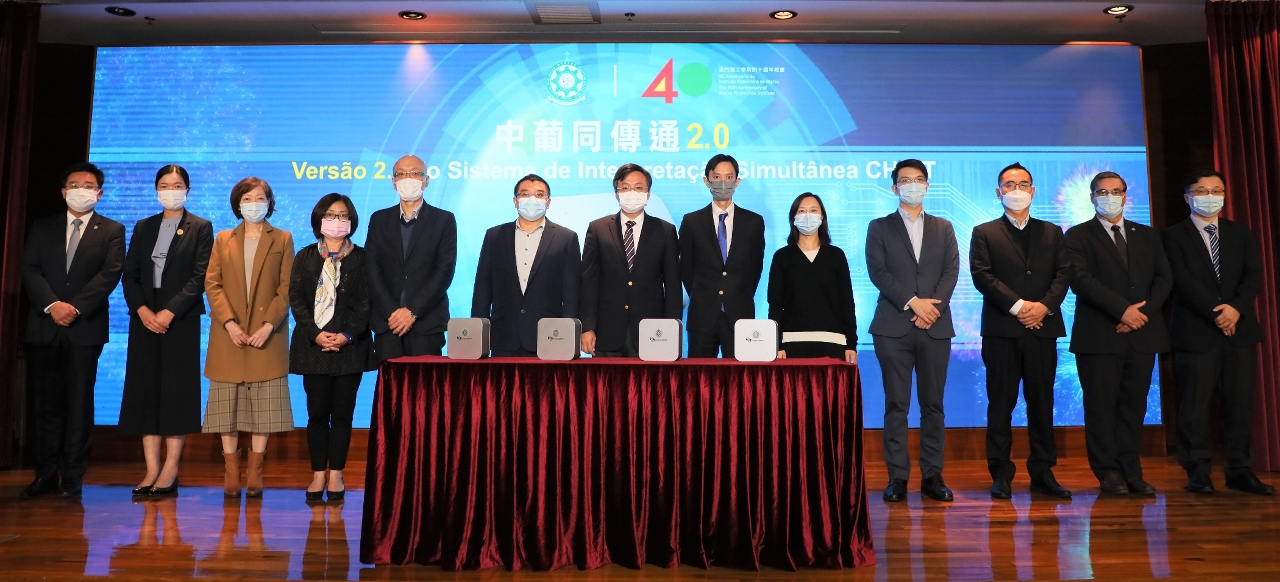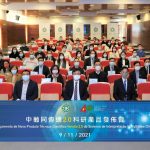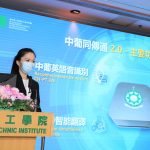 Macao Polytechnic Institute launched "Chinese-Portuguese Simultaneous Interpretation Machine Translation System" product to assist the Guangdong-Macao in-depth cooperation zone in Hengqin
Macao Polytechnic Institute launched "Chinese-Portuguese Simultaneous Interpretation Machine Translation System" product to assist the Guangdong-Macao in-depth cooperation zone in Hengqin
To complement the development strategies of " the Belt and Road", exert the role of Macao as a service platform between China and Portuguese-speaking countries, and assist in the construction of the Guangdong-Hong Kong-Macao Greater Bay Area and the Guangdong-Macao in-depth cooperation zone in Hengqin, the "Chinese-Portuguese Simultaneous Interpretation Machine Translation System 2.0", developed by the Engineering Research Centre of Applied Technology on Machine Translation and Artificial Intelligence, Ministry of Education, at Macao Polytechnic Institute (MPI)" was officially launched at MPI on the afternoon of November 9th. The new product is an industry-leading system of Chinese-Portuguese speech recognition and simultaneous interpretation, built in conjunction with the Greater Bay Area as an international innovation center of science and technology. Additionally, it has increased practical functions and human-machine interaction experience, whilst also improving the accuracy of speech recognition and machine translation to tie in with the development blueprints in increasing technology research and development, and developing industries such as Big Data, Artificial Intelligence and the Internet of Things for the construction of the Guangdong-Macao in-depth cooperation zone in Hengqin. The new product is welcome to be used by government departments and every industry organization.
The event was attended by the heads and representatives from 40 government departments and organizations of the Macao SAR, including Im Sio Kei, President of Macao Polytechnic Institute; Sam Weng Chon, Deputy Director of the Infrastructure Development Office; Kuan Kun Fan, Consultant of the Secretariat of Legislative Assembly; U Kam, Head of the Judicial Affairs Department of the Public Prosecutions Office; Vong Kuai Ieng, Head of the Department of Language Affairs of Public Administration and Civil Service Bureau; Pong Kai Fu, Head of the Research Department of Economic and Technological Development Bureau; Carlos Roberto Xavier, Head of the Department of Tertiary Education of Education and Youth Development Bureau; Ng Chi Keong, Head of the Department of Legal Translation of the Legal Affairs Bureau; Li Yang, the Director of the Secretariat of Macau Association of Banks; etc., who jointly witnessed the application of the latest scientific research product of MPI. The event was filled with a lively atmosphere.
At the press conference, Zhang Yunfeng, Director of the Centre for Portuguese Studies of MPI, introduced that the Engineering Research Centre of Applied Technology on Machine Translation and Artificial Intelligence, Ministry of Education, at MPI, is the first engineering research centre of the Ministry of Education in Hong Kong and Macao. The Centre has built the world's largest, most accurate pairing, most professional classifying and high quality bilingual parallel corpus between Chinese and Portuguese, and developed the world’s most accurate machine translation platform of Chinese-Portuguese neural network, on which a series of products has been developed. Among the products, the "Machine-Aided Translation System of Chinese-Portuguese/Portuguese-Chinese Official Documents" has been widely used by many government departments, industry associations, banks and other organizations in Macao, as well as "the Belt and Road" Portuguese-speaking countries. As the only engineering research centre of the Ministry of Education in China, focusing on machine translation and artificial intelligence, the Engineering Research Centre has made a breakthrough and achieved key results in the aspects of developing a neural network classification system to enhance the accuracy of artificial intelligence, conducting research on machine translation quality assessment and intervention system, building smart life based on Internet of Things, exploring the construction of a smart city in the era of Big Data, and using machine translation to better introduce China to "the Belt and Road" Portuguese-speaking countries, etc. In the future, the Centre will continue to explore the areas of comprehensive innovation research, application development and talent cultivation, achieve breakthroughs in core technology through in-depth interdisciplinary cooperation, and help promote the Guangdong-Macao in-depth cooperation zone in Hengqin as an important fulcrum of an international innovation center of science and technology in the Greater Bay Area.
The lecturer of the Engineering Research Centre of MPI, Lin Manlin, introduced that the "Chinese-Portuguese Simultaneous Interpretation Machine Translation System 2.0" is based on a 10-million-level bilingual parallel corpus, developed independently by MPI, using neural network technology, combined with multilingual recognition and speech synthesis technology. The product can realize high quality simultaneous interpretation in Chinese and Portuguese, and multilingual transcription services, providing a complete solution for different occasions such as work meetings, business communication and forum speeches, as well as foreign language teaching and academic conferences, etc. Based on the original version of "Chinese-Portuguese Simultaneous Interpretation Machine Translation System 2.0", the stability, operation speed, transcription efficiency and translation accuracy have all been improved, so that the process of speech recognition and text translation can be completed in real time; meanwhile, the system's dynamic modification, automatic correction capability and terminology standardization have been greatly increased, thus saving a lot of time and human resources for translation work. At the press conference, a live demonstration session of "Chinese-Portuguese Simultaneous Interpretation Machine Translation System 2.0" was held to demonstrate the functions of instant translations from Chinese to Portuguese and Portuguese to Chinese.




